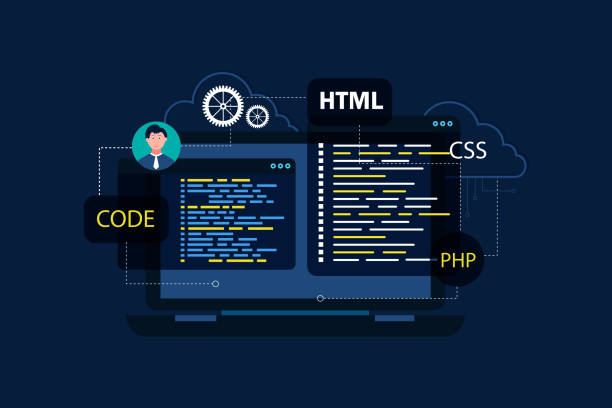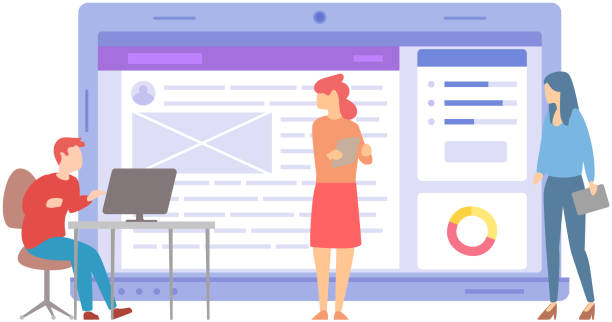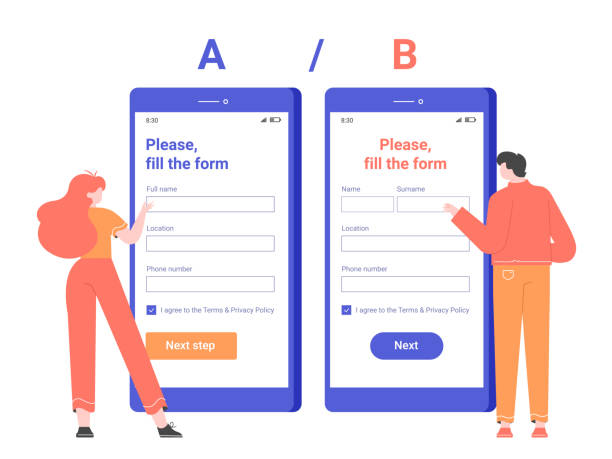The Unparalleled Importance of Secure Website Design in Today’s Digital World

In the current era, where businesses, social interactions, and even daily life have increasingly moved to the online space, the importance of #Secure Website Design and data protection is felt more than ever.
A website is not just a virtual storefront, but a base for storing sensitive user information, financial transactions, and trade secrets.
Imagine how vulnerable a website without sufficient security measures can be to cyberattacks.
These attacks not only lead to data loss and damage to company reputation, but can also inflict huge financial losses.
Common threats include SQL Injection, XSS, and DDoS attacks, each targeting the website’s infrastructure and content in a specific way.
Therefore, a proactive and comprehensive approach to secure website design is not just an option, but a vital necessity.
This process begins from the initial stages of site planning and architecture and continues through implementation, deployment, and maintenance.
The ultimate goal is to create a reliable and intrusion-resistant online environment where users can confidently benefit from its services.
Website security is no longer a luxury feature, but an inseparable part of its quality and functionality.
Therefore, knowledge of the basic principles and latest methods in this field is essential for every developer, webmaster, and online business owner.
This section serves as an explanatory and educational introduction, forming the foundation of our understanding of why website security is important.
Is your current e-commerce website design causing you to lose customers and sales?
Rasaweb is your solution with modern and user-friendly e-commerce website designs!
✅ Significant increase in conversion rates and sales
✅ Strong branding and building customer trust
⚡ Get a free e-commerce website design consultation from Rasaweb!
Fundamental Principles of Secure Web Development from a Professional Perspective

Secure website design goes beyond simply installing an SSL certificate; it requires implementing security principles across all layers of development and operations.
One of the most important of these principles is Input Validation.
Any data received from the user must be carefully checked and sanitized to prevent the injection of malicious code or unauthorized data.
This includes form inputs, URL parameters, and cookies.
Another principle is Secure Output (Output Encoding); this means ensuring that data displayed to users is properly encoded to prevent XSS attacks.
From a professional perspective, developers should always use secure APIs and frameworks and avoid outdated and insecure functions.
Proper error management is also crucial; error messages should not disclose sensitive information that attackers could exploit.
Furthermore, Session Management must be carried out in such a way that Session IDs are generated randomly and complexly, and protected against theft or forgery attacks.
Using Rate Limiting to prevent Brute Force attacks and using CAPTCHA to prevent robotic activities are also key measures in secure website design.
Proper implementation of Access Control to ensure that users only have access to resources they are authorized to view or modify is vital.
These fundamental principles provide comprehensive guidance for programmers to build websites with a strong security foundation from the outset.
Data Protection and High-Standard Database Security

Database security is the backbone of any secure website design.
Data, especially users’ personal and financial information, is the primary target for attackers.
Preventing SQL Injection attacks, which allow attackers to inject malicious SQL commands into the database, is of paramount importance.
Using Prepared Statements with input parameters is one of the most effective methods to prevent these attacks.
Also, applying the Principle of Least Privilege (PoLP) for database user accounts, meaning that each user or service only has access to the data necessary for its function, is one of the fundamental principles of data security.
Data Encryption, both at rest on disk and in transit over networks, provides another layer of defense.
The use of TLS/SSL for secure communications between the web server and the database, as well as between the user and the web server, is essential.
Regular and encrypted backups of the database, stored in a secure and separate location, are a vital component of a Disaster Recovery strategy.
This professional and explanatory approach also includes continuous monitoring of database activities to identify suspicious and unusual patterns.
Database Monitoring Tools can help detect anomalies and respond quickly to threats.
Ultimately, secure website design would not be complete without deep attention to database security.
To better understand these concepts, the table below provides a summary of key database security measures:
| Security Measure | Explanation | Benefit |
|---|---|---|
| Using Prepared Statements | Separating SQL commands from input data | Prevention of SQL Injection |
| Applying Least Privilege (PoLP) | Granting minimum necessary permissions to users and applications | Reducing the scope of vulnerability in case of intrusion |
| Data Encryption | Encrypting data at rest and in transit | Protecting sensitive information from unauthorized access |
| Regular and Secure Backups | Creating backup copies of the database and securely storing them | Enabling data recovery after attacks or failures |
| Database Activity Monitoring | Continuous monitoring of suspicious activities and logging | Rapid intrusion detection and timely response |
Securing the Network and Server Configuration for Multi-layered Defense

A significant part of secure website design is dedicated to proper server configuration and network hardening.
The website’s hosting server is the first line of defense against cyberattacks, and any weakness in its configuration can become an entry point for attackers.
The use of powerful firewalls, both software and hardware, is crucial for controlling inbound and outbound traffic and blocking unnecessary ports.
Web Application Firewalls (WAFs) are a more specialized protection layer that can analyze HTTP/S traffic and identify and block specific web application attacks like SQL Injection and XSS.
Secure server configuration includes disabling unused services, removing default and insecure applications, and using secure communication protocols like SSH instead of Telnet for remote access.
Regular updates of the server operating system, web server software (such as Apache or Nginx), and other infrastructure components to address known vulnerabilities are an essential guiding and professional measure.
Furthermore, implementing SSL/TLS certificates to encrypt all communications between the user’s browser and the server not only ensures data security but also helps improve the site’s SEO ranking.
Failure to comply with these can create serious vulnerabilities in website security.
For secure website design, even the smallest network and server settings must be configured with precision and full awareness of potential threats to create a multi-layered and robust defense against attackers.
Are you dissatisfied with the low sales of your e-commerce website?
Rasaweb is your solution for having a professional and high-selling e-commerce website.
✅ Significant increase in sales and revenue
✅ Easy and enjoyable shopping experience for customers
⚡ Get a free consultation from Rasaweb right now!
The Importance of Strong Authentication and Proper Session Management

Authentication and session management are two vital components in secure website design that are often overlooked but play a key role in preventing unauthorized access.
Strong password policies are the cornerstone of secure authentication.
These policies should include a requirement for long and complex passwords, containing a combination of uppercase and lowercase letters, numbers, and symbols.
Limiting the number of unsuccessful login attempts (Brute Force Protection) and locking the user account after several failed attempts are other essential measures.
Multi-Factor Authentication (MFA), such as using One-Time Passwords (OTP) or authentication applications, creates a powerful additional security layer and prevents attacker intrusion even if the password is compromised.
Session Management must also be performed carefully.
Session IDs must be generated randomly and unpredictably and transmitted over HTTPS.
These IDs should have a short expiration time and be invalidated after user logout or a specified period of inactivity.
Additionally, preventing Session Hijacking and Session Fixation through security measures such as regenerating Session IDs after successful login and using the HttpOnly flag for session cookies, is vital.
This specialized and guiding section emphasizes the fact that even the strongest encryptions will be useless without proper authentication and session management.
A secure website requires robust authentication and session management mechanisms.
Identifying and Preventing Common Website Vulnerabilities

For a secure website design, understanding common web vulnerabilities and methods to prevent them is essential.
The OWASP (Open Web Application Security Project) organization publishes a list of the top ten web vulnerabilities, which is a valuable educational and analytical resource.
Among these vulnerabilities, Cross-Site Scripting (XSS) allows attackers to inject malicious code into users’ browsers.
To counter XSS, all user inputs must be properly validated and site outputs correctly encoded.
Another vulnerability is Cross-Site Request Forgery (CSRF), where an attacker tricks the user into sending unwanted requests to the website.
Using CSRF tokens in forms and validating the Referer header can prevent these attacks.
DDoS (Distributed Denial of Service) attacks are performed with the aim of disrupting service through a high volume of malicious traffic.
Using DDoS protection services and CDN (Content Delivery Network) can help repel these attacks.
Insecure Deserialization, which allows an attacker to execute arbitrary code, and Security Misconfiguration, which results from improper server or application configuration, are also serious threats.
Managing Vulnerable Components, meaning using up-to-date and secure libraries and frameworks, and continuously checking for known vulnerabilities in them, is an important step in securing the site.
This explanatory and analytical section emphasizes that awareness of these vulnerabilities and the implementation of prevention strategies are the core of any secure website design.
By deeply understanding these threats and countermeasures, we can build websites that withstand modern attacks.
Periodic Security Audits and Penetration Testing for Secure Websites

Even with adherence to all principles of secure website design, it cannot be guaranteed that your website is completely safe from threats.
The world of cybersecurity is dynamic, and new vulnerabilities and attack methods are discovered every day.
For this reason, conducting periodic security audits and penetration testing is essential for maintaining website security.
Penetration testing is the simulation of real cyberattacks performed by security professionals (ethical hackers) to identify weaknesses before real attackers exploit them.
This specialized and guiding process includes various types of tests: Black Box Testing which is performed without any prior information about the system, White Box Testing which is done with full access to the source code and infrastructure, and Gray Box Testing which is a combination of the two.
In addition to manual penetration testing, using automated vulnerability scanning tools like Nessus or Acunetix can also help quickly identify common issues.
After each test, a comprehensive report of discovered vulnerabilities and recommendations for their remediation is provided, which should be acted upon immediately.
This analytical and informative approach helps managers stay informed about the latest security status of their website and turn secure website design into a continuous process.
The importance of this stage is such that many organizations consider penetration testing mandatory annually or after any significant system change.
The table below shows important tools in security auditing:
| Audit Type/Tool | Explanation | Purpose |
|---|---|---|
| Penetration Test (PenTest) | Simulating real attacks by specialists | Identifying vulnerabilities from an attacker’s perspective |
| Vulnerability Scanner | Automated tools for identifying known weaknesses | Rapid discovery of common vulnerabilities and misconfigurations |
| Code Review | Manual examination of source code to find security bugs | Identifying logical and application-specific vulnerabilities |
| Security Configuration Assessment | Reviewing security settings of servers, databases, and software | Ensuring best practices are followed and preventing misconfiguration |
| Log Auditing | Regular review of system and security logs | Detecting suspicious activities and intrusion attempts |
Incident Response and Disaster Recovery Plan

Even with the best secure website design and strongest preventive measures, no website is 100% immune to attacks.
Security Incidents can occur, and how you react to them can make a big difference in the extent of the damage.
Having a precise and pre-determined Incident Response Plan is crucial.
This guiding and informative plan should include stages of identification, containment, eradication, recovery, and lessons learned.
Identification means rapid detection of an intrusion or attack, which is possible through monitoring systems, IDS/IPS, and regular log reviews.
Containment includes measures to prevent the spread of the attack, such as isolating infected systems or blocking malicious traffic.
Eradication means the complete removal of the intrusion agent (such as malware or attacker’s user account) and remediation of the vulnerability.
Following that, the recovery phase begins, which involves restoring systems and data to normal operational status using secure backups.
Finally, lessons learned from the incident are crucial for continuous security improvement and future secure website design.
A Disaster Recovery Plan (DRP) is also an inseparable component that specifies how to restore systems and data in the event of a larger disaster (such as server failure, fire, or natural disasters).
This plan includes maintaining offline backups in different geographical locations, and regular drills to ensure its effectiveness.
This informative and professional perspective shows that security does not end with prevention; rather, preparedness for response and recovery is also a vital part of a secure website.
Does losing customers who visited your site to buy bother you?
Rasaweb is your specialized solution for having a successful online store.
✅ Significant increase in your online sales
✅ Building trust and professional branding with customers⚡ Get a free consultation from Rasaweb experts!
The Future of Web Security and Emerging Challenges in the Web World

The world of cybersecurity is constantly evolving, and secure website design must keep pace with these changes.
Emerging challenges require new analytical approaches and question-provoking content.
One of the most important trends is the use of Artificial Intelligence (AI) and Machine Learning (ML) in cyber defense and attack.
AI can identify malicious traffic patterns more quickly and enable security systems to respond to threats automatically.
But on the other hand, attackers also use AI to create more sophisticated malware and targeted attacks.
Quantum Computing is a potential threat to current encryption algorithms.
Although still in its early stages, the development of Post-Quantum Cryptography is underway to counter this forward-looking threat.
Increased attacks on APIs and Microservices, which are the backbone of many modern web applications, are also a significant challenge.
API security requires special attention to authentication, validation, and access management.
Supply Chain Attacks, carried out by infiltrating the software and library supply chain, have also raised new concerns.
To counter these threats, we need an analytical and specialized approach that includes continuous monitoring, rapid updates, and the development of secure website design considering more complex attack scenarios.
The question is: Are we moving fast enough to stay ahead of the threat curve? The answer to this question requires continuous investment in research and development and knowledge sharing within the cybersecurity community.
Conclusion and the Importance of Continuous Education in Secure Web Design

At the end of this comprehensive journey into the world of secure website design, we realize that web security is not a destination, but a continuous journey.
This process begins with initial risk assessment, extends to implementing secure coding and robust server configurations, and continues with continuous monitoring, penetration testing, and incident response.
There is no single magic solution for security; rather, it is a combination of best practices, tools, and of course, a Security Mindset that builds a secure website.
The educational and engaging part of this article emphasizes the importance of awareness and education.
Whether you are a developer, a system administrator, or a business owner, you must constantly update your knowledge regarding the latest security threats and solutions.
Security conferences, webinars, online courses, and reputable resources like OWASP are valuable tools for continuous learning.
Secure website design is a shared responsibility.
The development team, operations team, and even end-users each play a role in maintaining the overall system security.
Encouraging the use of strong passwords and educating users about phishing and other social engineering attacks are examples of user participation in this security ecosystem.
Remember that a successful attack can destroy years of your reputation and effort.
Therefore, investing in secure website design is not an expense, but a vital investment for the future and sustainability of your online business.
With a continuous and comprehensive approach to security, we can build websites that not only perform excellently but also provide a safe and reliable place for all users.
Frequently Asked Questions
| Question | Answer |
|---|---|
| What is secure website design? | Secure website design is a process in which websites are built with security principles in mind to be resistant to cyberattacks and to protect user and business information. |
| Why is secure website design of high importance? | To prevent unauthorized data access, sensitive information leaks, malware attacks, loss of user trust, damage to business reputation, and legal consequences resulting from data breaches. |
| What are the most common website vulnerabilities? | SQL Injection, Cross-Site Scripting (XSS), Cross-Site Request Forgery (CSRF), broken authentication and session management, and sensitive data exposure. |
| How can SQL injection attacks be prevented? | By using Prepared Statements with parameterized queries, input validation, and restricting database access. |
| What are the methods to counter XSS (Cross-Site Scripting) attacks? | User input validation, output encoding before displaying in HTML, and using Content Security Policy (CSP). |
| What is the role of HTTPS in website security? | HTTPS encrypts the communication between the user’s browser and the website server using an SSL/TLS certificate, preventing eavesdropping, tampering, or forgery of data. |
| What are the best practices for user password management? | Enforcing strong passwords (a combination of letters, numbers, and symbols), hashing passwords instead of storing them directly (with strong algorithms like bcrypt), and enabling two-factor authentication (2FA). |
| What is the importance of User Input Validation? | Input validation prevents malicious or unexpected data from entering the system, which can lead to vulnerabilities such as SQL Injection or XSS. |
| What impact do regular security reviews and audits have on site security? | These reviews help in early identification of vulnerabilities and security weaknesses, enabling their remediation before they can be exploited. |
| What is the use of Web Application Firewall (WAF) in secure website design? | A WAF acts as a protective layer between the user and the website, analyzing incoming traffic and identifying and blocking common web attacks like SQL Injection and XSS. |
And other advertising services of Rasaweb Advertising Agency
Smart Google Ads: A combination of creativity and technology to increase sales through custom programming.
Smart Google Ads: A professional solution for customer acquisition focusing on precise audience targeting.
Smart Digital Advertising: An innovative service for increasing digital branding through Google Ads management.
Smart Custom Software: Revolutionize customer behavior analysis with the help of Google Ads management.
Smart Digital Advertising: An effective tool for digital branding through user experience customization.
And over hundreds of other services in internet advertising, advertising consultation, and organizational solutions
Internet Advertising | Advertising Strategy | Advertorials
? Are you ready to take your business to new heights in the digital world? Rasaweb Afarin Digital Marketing Agency, specializing in modern UI website design, professional SEO, and targeted advertising campaigns, is your key to success. With us, establish a powerful and lasting online presence.
📍 Tehran, Mirdamad Street, next to Bank Markazi, Southern Kazeroon Alley, Ramin Alley, No. 6

